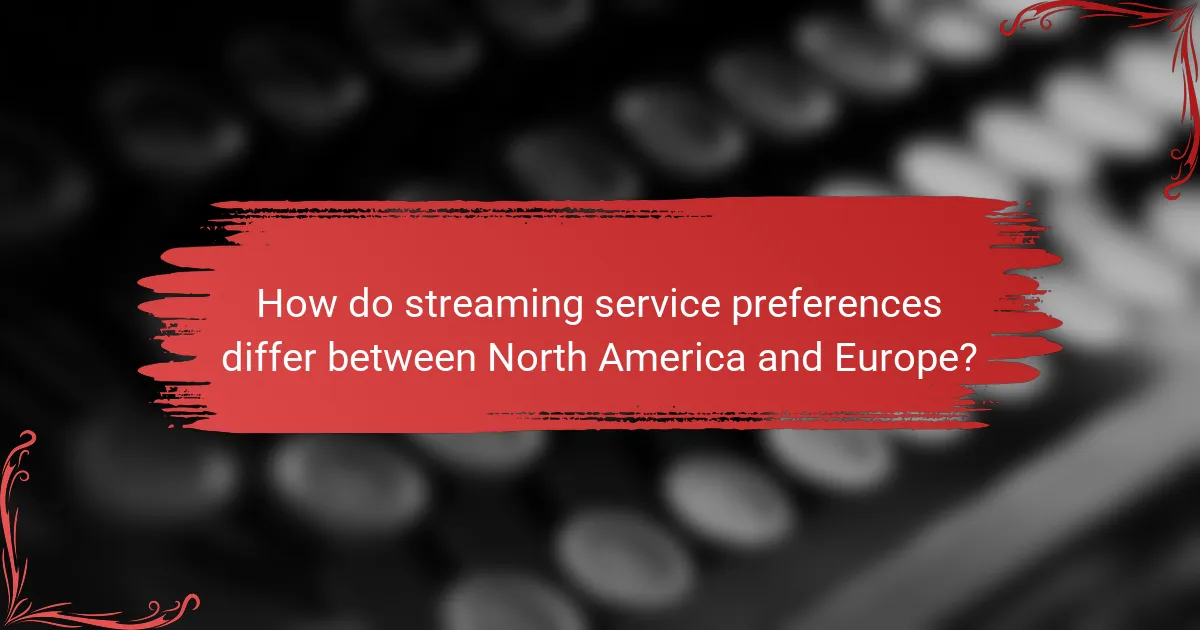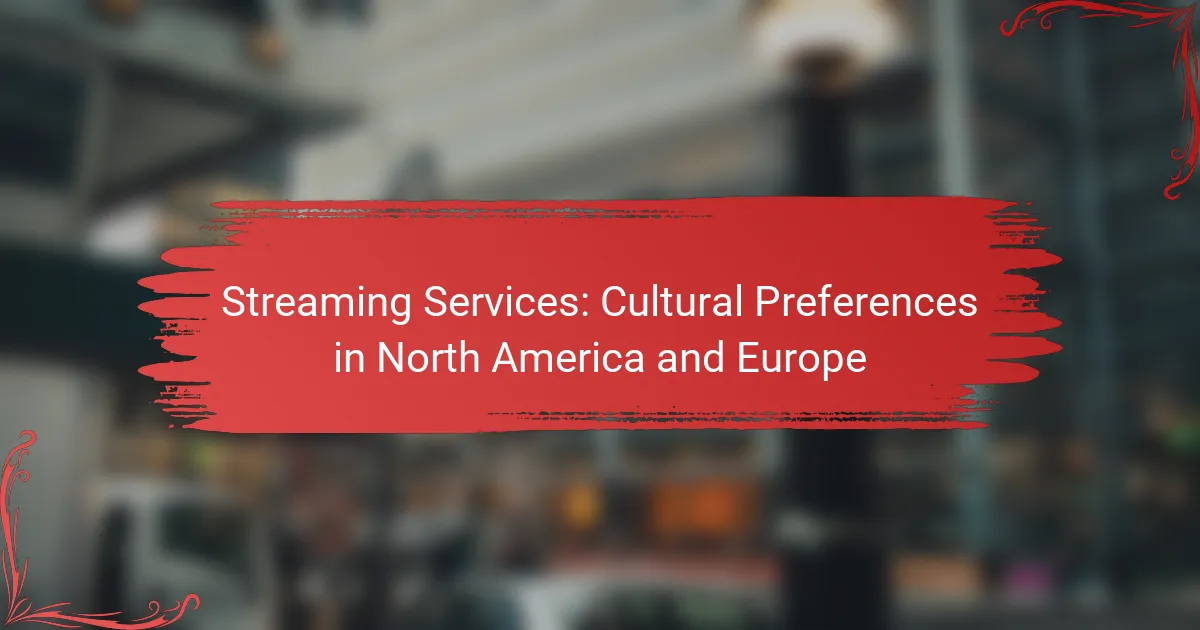Streaming service preferences in North America and Europe reveal distinct cultural influences that shape viewer choices. In North America, platforms like Netflix and Hulu dominate, while European audiences often prefer services such as BBC iPlayer and Canal+. These preferences are driven by factors such as content diversity, regional tastes, and local narratives, highlighting the importance of cultural identity in media consumption.

How do streaming service preferences differ between North America and Europe?
Streaming service preferences vary significantly between North America and Europe, influenced by cultural tastes, content availability, and regional regulations. North American audiences tend to favor platforms like Netflix and Hulu, while European viewers often gravitate towards services such as BBC iPlayer and Canal+.
North American preferences for Netflix and Hulu
In North America, Netflix dominates the streaming landscape, appealing to a wide audience with its extensive library of original content and licensed shows. Hulu, on the other hand, is popular for its next-day access to current TV episodes and a strong selection of classic series.
Viewers in this region appreciate the convenience of binge-watching and ad-supported options, which can lower subscription costs. The competition between these platforms drives them to continuously enhance their offerings, making it essential for users to stay informed about new releases and exclusive content.
European preferences for BBC iPlayer and Canal+
In Europe, BBC iPlayer is a leading choice, particularly in the UK, due to its extensive catalog of British programming and live TV options. Canal+, popular in France, offers a mix of films, series, and sports, catering to diverse viewing preferences.
European audiences often value local content and regional productions, which these services provide. Additionally, regulations around broadcasting and content rights can affect availability, making it important for viewers to understand the specific offerings in their country.

What cultural factors influence streaming service choices in North America?
Cultural factors significantly shape the streaming service preferences in North America, including content diversity, regional tastes, and user engagement styles. These influences determine which platforms gain popularity and how consumers interact with available services.
Impact of regional content availability
Regional content availability plays a crucial role in streaming service choices. North American audiences often prefer platforms that offer a mix of local and international content, reflecting their diverse cultural backgrounds. Services like Netflix and Hulu invest heavily in original programming that resonates with various demographics, enhancing viewer loyalty.
For example, platforms that provide popular local shows or movies, such as “Schitt’s Creek” or “The Office,” tend to attract larger audiences. Additionally, the availability of sports content, particularly in the U.S. and Canada, can significantly influence subscriptions, as many viewers seek live sports streaming options.
Influence of advertising and subscription models
The choice between ad-supported and subscription-based models affects how North Americans select streaming services. Many consumers prefer ad-free experiences, leading them to choose subscription options, while others may opt for lower-cost, ad-supported tiers. This preference can vary by age group, with younger audiences often more tolerant of ads.
For instance, platforms like Peacock and Hulu offer both models, allowing users to select based on their budget and viewing habits. Understanding these preferences can help streaming services tailor their offerings to meet the demands of different audience segments, ultimately enhancing user satisfaction and retention.

What cultural factors influence streaming service choices in Europe?
Cultural factors significantly shape streaming service preferences in Europe, particularly regarding local content, language options, and regulatory frameworks. Viewers often gravitate towards platforms that offer familiar narratives and languages, reflecting their cultural identities.
Preference for local content and language options
European audiences typically favor streaming services that provide content in their native languages and reflect local cultures. This preference can lead to higher engagement and satisfaction, as viewers relate more to stories and characters that resonate with their own experiences.
For instance, platforms like Netflix and Amazon Prime Video have invested heavily in producing local series and films across various European countries. This strategy not only caters to local tastes but also helps in building a loyal subscriber base.
Regulatory impacts on streaming services
Regulatory frameworks across Europe can significantly influence streaming service operations and content availability. Many countries enforce quotas requiring platforms to feature a certain percentage of European works, which can affect the overall content library.
Additionally, the European Union’s Digital Services Act aims to create a safer online environment, impacting how streaming services manage content moderation and user data. Companies must navigate these regulations carefully to ensure compliance while meeting viewer expectations.

How do user demographics affect streaming service usage?
User demographics significantly influence streaming service usage patterns, with factors such as age, income, and location playing crucial roles. Different age groups tend to prefer specific types of content and platforms, which affects their overall engagement with streaming services.
Age group preferences in North America
In contrast, viewers aged 35 and older may gravitate towards services like Amazon Prime Video or cable alternatives, valuing a mix of classic films and family-oriented content. This group often prefers subscription models that offer a wider range of viewing options.
Age group preferences in Europe
In Europe, streaming service preferences vary significantly by country, but younger viewers typically favor platforms such as Disney+ and Netflix for their extensive libraries and exclusive releases. This demographic is keen on international content, reflecting a broader cultural interest.
Older European audiences, particularly those over 50, often prefer local content and may choose services that offer regional programming, such as BBC iPlayer in the UK or ZDF Mediathek in Germany. This age group tends to appreciate traditional viewing habits, including live television options alongside on-demand services.

What are the pricing strategies for streaming services in North America?
Streaming services in North America employ various pricing strategies, primarily focusing on subscription models and ad-supported tiers. These strategies cater to diverse consumer preferences, balancing affordability and content access.
Subscription models of Disney+ and Amazon Prime Video
Disney+ and Amazon Prime Video utilize subscription models that offer users access to a vast library of content for a monthly or annual fee. Disney+ typically charges around $8 to $10 per month, while Amazon Prime Video is included with an Amazon Prime membership, which costs about $14 per month or $139 annually.
Both platforms provide options for bundling services. For instance, Disney+ offers packages that include Hulu and ESPN+, enhancing value for families and sports fans. Users should consider their viewing habits and whether these bundles align with their interests to maximize savings.
Ad-supported tiers of Peacock and Paramount+
Peacock and Paramount+ offer ad-supported tiers as a lower-cost alternative to their premium subscriptions. Peacock’s ad-supported plan is priced around $5 per month, while Paramount+ charges approximately $5 to $6 monthly for its ad-supported version. These options attract budget-conscious consumers who are willing to watch advertisements in exchange for reduced fees.
While ad-supported tiers can save money, they come with trade-offs such as limited content access and interruptions during viewing. Users should evaluate how much they value ad-free experiences versus cost savings when choosing between subscription options.

What are the pricing strategies for streaming services in Europe?
In Europe, streaming services employ various pricing strategies to attract and retain subscribers. These strategies often include free ad-supported options, subscription models, and tiered pricing based on content access and features.
Free ad-supported services like Pluto TV
Free ad-supported streaming services, such as Pluto TV, offer users access to a wide range of content without any subscription fees. Instead, these platforms generate revenue through advertisements, which can lead to a less seamless viewing experience due to commercial interruptions.
These services are particularly appealing to budget-conscious viewers who prefer not to pay for content. However, the trade-off is often a limited selection of shows and movies compared to paid services.
Subscription models of Viaplay and RTL+
Subscription-based services like Viaplay and RTL+ provide users with ad-free viewing experiences and access to premium content. These platforms typically offer different pricing tiers, allowing users to choose plans based on their content preferences and budget.
For instance, Viaplay may offer a basic plan with limited content and a premium plan that includes exclusive shows and movies. Users should consider their viewing habits and the specific content available on each platform when selecting a subscription model.

What emerging trends are shaping the future of streaming services?
Emerging trends in streaming services are largely driven by consumer preferences and technological advancements. Key developments include the rise of hybrid models that combine subscription and ad-supported content, as well as an increased emphasis on original programming to attract and retain viewers.
Growth of hybrid models in North America
Hybrid models are gaining traction in North America, where services are blending subscription fees with advertising. This approach allows platforms to offer lower-priced options while maintaining revenue streams through ads, appealing to cost-conscious consumers.
For example, platforms like Hulu and Peacock have successfully implemented hybrid models, allowing users to choose between ad-supported tiers and ad-free subscriptions. This flexibility caters to diverse viewer preferences and budgets, making streaming more accessible.
Increased focus on original content in Europe
In Europe, streaming services are placing a stronger emphasis on original content to differentiate themselves in a competitive market. This trend is driven by the desire to create unique offerings that resonate with local audiences while also attracting international viewers.
Services such as Netflix and Amazon Prime Video are investing heavily in European productions, resulting in a variety of shows and films that reflect regional cultures and languages. This strategy not only enhances viewer engagement but also helps platforms comply with local content regulations, such as the European Union’s Audiovisual Media Services Directive.

How will cultural preferences evolve in the streaming landscape?
Cultural preferences in the streaming landscape are likely to evolve as audiences seek more localized content that resonates with their identities. Factors such as regional trends, language, and cultural narratives will shape how streaming services curate their offerings in North America and Europe.
Regional Content Demand
In North America, there is a growing appetite for diverse content that reflects various cultural backgrounds. This trend is evident in the increasing popularity of shows and films that highlight underrepresented communities, leading platforms to prioritize inclusive storytelling.
Conversely, European audiences often favor content that aligns with their national identities and languages. Streaming services are responding by investing in local productions, which not only cater to regional tastes but also comply with regulations promoting local content.
Language Preferences
Language plays a crucial role in shaping streaming preferences. In North America, English-language content dominates, but there is a rising interest in Spanish and other languages due to demographic shifts. This shift encourages platforms to offer subtitles and dubbing options to attract a broader audience.
In Europe, multilingual content is essential, with countries like Belgium and Switzerland showcasing a mix of languages. Streaming services must navigate these linguistic landscapes to ensure accessibility and engagement, often providing multiple audio tracks and subtitles.
Cultural Trends and Influences
Cultural trends significantly influence viewing habits. In North America, the rise of social media has led to a demand for content that is shareable and relatable, prompting streaming platforms to create interactive and community-driven experiences.
In Europe, cultural influences such as festivals, historical events, and local traditions shape content preferences. Streaming services that align their offerings with these cultural moments can enhance viewer engagement and loyalty.
Regulatory Considerations
Regulations regarding content quotas and local productions are increasingly impacting streaming services. In Europe, the Audiovisual Media Services Directive mandates that a certain percentage of content must be European, pushing platforms to invest in local talent and stories.
In North America, while regulations are less stringent, there is growing scrutiny on content diversity and representation. Streaming services must remain vigilant about these evolving standards to maintain compliance and audience trust.
